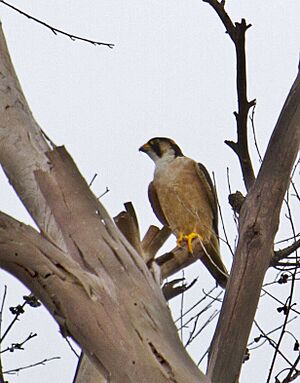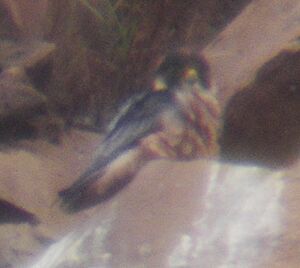Taita falcon facts for kids
Quick facts for kids Taita falcon |
|
|---|---|
 |
|
| photographed at Chimanimani National Park, Zimbabwe | |
| Conservation status | |
| Scientific classification | |
| Genus: |
Falco
|
| Species: |
fasciinucha
|
The Taita falcon (Falco fasciinucha) is a small falcon that lives in central and eastern Africa. It got its name because it was first found in the Taita Hills of Kenya.
Contents
What Does the Taita Falcon Look Like?
The Taita falcon is a small, strong bird of prey. It has long wings and a short tail. This helps it hunt very well while flying.
It looks a bit like the African hobby falcon. But you can tell the Taita falcon apart by its white throat. It also has reddish-brown patches on the back of its neck.
Male falcons have a wingspan of about 202 to 208 mm (8.0 to 8.2 in). Females are a bit bigger, with wingspans from 229 to 240 mm (9.0 to 9.4 in). Males weigh about 212 to 233 g (7.5 to 8.2 oz), and females weigh 297 to 346 g (10.5 to 12.2 oz). Male falcons also have brighter colors than females.
Where Do Taita Falcons Live?
The Taita falcon is considered a Vulnerable animal. This means it is at risk of becoming endangered. Scientists believe there are fewer than 1500 of these birds left. Only about 50 places where they nest are known.
These falcons are hard to find because they live in remote areas. This makes it tough to know their exact numbers. Their populations can also change a lot over time.
Taita falcons live in many places across Africa. Their homes are spread out from South Africa up to southern Ethiopia. They like to live in highlands and mountains. These areas usually have low rainfall. They prefer forests that are not broken up by human activity.
How Do Taita Falcons Reproduce?
Taita falcons usually build their nests in holes on cliffs. These spots protect their eggs from direct sunlight. Some falcons in Malawi and Zambia also nest on small granite hills.
In Zimbabwe, they usually start breeding around July and finish by October. The eggs hatch after about 31 to 33 days. The young birds are ready to fly after about 42 days.
A female Taita falcon usually lays two to four eggs. They are very secret about their nests. They will fiercely attack other animals that come too close. This includes birds like trumpeter hornbills.
How Do Taita Falcons Hunt and What Do They Eat?
The Taita falcon is a small, fast bird of prey. It catches its food while flying in the air. These falcons are most active in the morning and late afternoon.
They have small wings for their strong bodies. This allows them to fly very fast when hunting. Cliffs are great places for them to live. They offer safe spots for nests. Cliffs also help the falcons use air currents to save energy while flying. Plus, they give a good view for spotting prey.
Taita falcons mostly hunt small birds. They catch birds like red-billed queleas, swifts, and green-spotted doves. They often hunt close to their nests.
These falcons use different hunting styles. Sometimes they fly from a cliff top to look for prey. Other times, they dive from high up to chase a bird. Some have even been seen hunting together in Zimbabwe.
What Threats Do Taita Falcons Face?
The Batoka Gorge, near Victoria Falls, used to be a main home for Taita falcons. But now, fewer falcons live there. Scientists are not sure why their numbers are dropping.
Here are some possible reasons:
- Human Activity: More tourism and air traffic can disturb these birds.
- Water Quality: The Zambezi River's water quality has changed. This affects insects, which then affects birds that eat insects. Since Taita falcons eat these insect-eating birds, their food supply can shrink.
- Pesticides: Chemicals used in farming can harm insects. This also reduces the food available for birds that the falcons eat.
- Habitat Loss: As more people move into areas around Batoka Gorge, forests are cut down. This creates open spaces that are not good for Taita falcons. Other raptors, like Lanner falcons, prefer these open areas. This means less suitable home for the Taita falcon.
- Competition: In East Africa, Taita falcons might compete for food and nest sites with larger birds. These include the peregrine falcon and the lanner falcon. These bigger falcons might also hunt young Taita falcons.
- New Construction: Plans to build a power plant near Victoria Falls could also harm the birds in the area.
Protecting the Taita falcon means making sure they have safe nesting spots and enough food.



